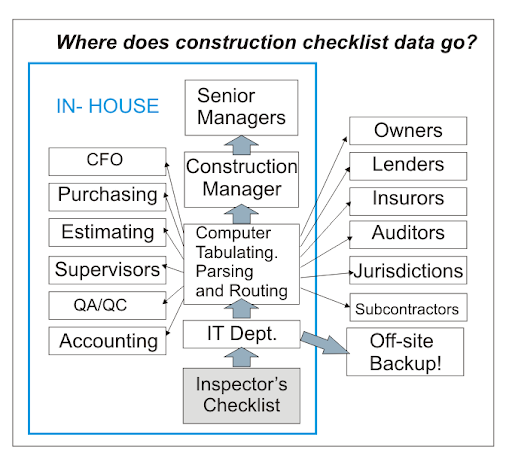
Construction checklists are like small, simplified snapshots of the real world tailored for the construction industry. While they aren’t meant to be complete or exhaustive, they are incredibly useful. A fully detailed checklist would be too bulky to use efficiently and would need constant updates.
Instead, checklists act as memory aids—helping you save mental energy and making complex construction projects more manageable and streamlined.
But checklists are more than just reminders. They serve as critical control points in a construction project, helping ensure key tasks are completed properly and nothing important is overlooked.
Depending on its function and the users, an inspection checklist usually represent multiple categories like processes, materials and specifications. A simple version that a small, residential contractor creates for his own construction work might look like this:
Residential Construction Checklist Template Example
- Excavation
- Footer Forms Installed
- Rebar Placed
- Rebar Inspected
- Footer Pour
- Forms Removed
- Blocks, Sand, Mortar
- Temp, power pole
As jobs get more complex, lists need more data fields because they serve multiple purposes and become communication and management system tools.
Checklists are a useful tool for keeping an inspection record and help you conduct accurate and detailed inspections. After the inspection is complete, the checklist can be used to review what was found and what was done about it.
Archived, they have legal (forensic) applications and may need to serve as exhibits in courts of law.
For example, a subcontractor disputes a large chargeback, or a structural engineer may need them if tasked with a failure analysis.
The history of inspection data for subcontractors helps you determine whether to use them again in the future.
Another example use case might be: “This company was cheaper and did acceptable work, but they were slow and held up other job phases for 8 days. We should have taken the next cheapest bid.”
The construction manager who made this decision may never have met the subcontractor or seen their work. The supervisor’s checklist tells the story, and the manager can make the decision at his desk, by analyzing report data.
Digitized inspection data means that a company can expand and do more efficient work with reduced overheads. Construction processes that rely on using collective personal memories to assess quality performance are subject to making decisions based more on emotional triggers rather than facts.
Checklists can be quantified and cross-referenced by multiple criteria. For example, let’s assume that the user is the general manager, owner or general contractor who is building a high-rise residence, with hundreds of millions of dollars at stake.
All of these parties will have a serious interest in the work being done by dozens of general contractors and hundreds of sub-contractors. For a high-rise, which is a complex system, the overall success is dependent on every job phase: From parking and plumbing through to signage and public relations and ultimately a well-oiled system with happy, profitable tenants.
Regular inspections and comprehensive building work checklists make the inspector’s job much easier.
In cases like a high-rise, where a major construction site might temporarily triple building activity, QA teams can become overwhelmed. Having checklists for each stage of construction can help make sure that required inspections are not missed.
Each stage is dependent on the previous stage being signed off before it can commence: Until framing, plumbing and roughed in electrical are approved, walls can’t be closed in. Then, subsequent trades can proceed. Drywallers, tapers, finish carpenters, painters, and sign installers and so on.
A good checklist system will help a general contractor plan an inspector’s schedule. For a large job, on any given day, one inspector may have dozens of different inspections to make. To avoid confusion and time lost on orientating the inspector with the job, inspection plans should detail which checklists should be used, where they should be used, and when.
A well-tuned checklist system means that an inspector will have more confidence in a contractor's work being completed properly. It is a well understood principle in the construction business that a systematic inspector who uses checklists does a better job inspecting the quality of work.
The Construction Checklist Data Flow
Construction Inspection Checklists are important for everyone involved in a construction project. They ensure that all parties are on the same page and that everyone is working efficiently.

The inspection data from checklists should be distributed on a need-to-know basis, because not all recipients need (or should have) all the data.
A purpose-built quality management platform can do a lot with checklist inspection data beside creating an inspection report:
- Keeping management informed
- Notify purchasing departments that a job phase is complete and new materials are needed
- Notify subcontractors that it’s time for their phase to start, for example - slab reinforcement inspection complete, ready to pour
Who gets what information and when, is a crucial decision.
While top management will want to have access to all the data, they will usually never want to see the raw inspection reports.
Project managers may want an executive report on progress of the inspection plan while superintendents may want a list of outstanding deficiencies.
A major portion of a quality management platform is designed to provide specialized reports which are targeted and provide tailored reports for each recipient.
The Dollar Value of Using Checklists
Suppose a project management company is currently doing a 35-million-dollar project that will take a year to complete and will yield a 10% profit. If the current project management burn rate of $5,000 per day is applied, this translates to $3,500,000.
If a digital checklist system is part of the QA/QC and it saves two weeks in the life of a project, it will add another $70,000 to the profit in total. This is just one tangible benefit for one construction project.
When we multiply the value of all projects, we see a compelling motivator to digitalize the checklist system.
FTQ360 Checklist QA/QC Platform
With our platform, you can create an effective process for translating quality requirements across all subdivisions of your residential projects. This ensures consistent quality and helps you avoid cost overruns throughout the building process.
Our digital quality and inspection checklist app replaces outdated paper checklists, making it easy to manage inspections efficiently and accurately.
If you're automating your inspection processes, it's essential to use quality management checklists that help eliminate recurring issues. With FTQ360’s purpose-built quality control forms and checklists, you can perform standardized inspections that consistently meet regulatory standards—every time.
To experience the benefits of using the FTQ360 QA/QC platform, take a free 30-day trial.

